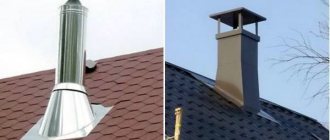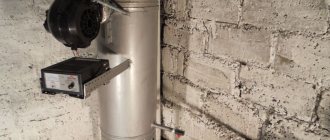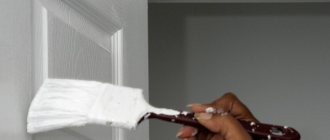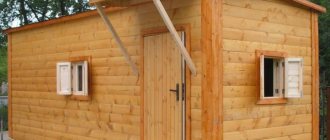To prevent doors from remaining open, they used to use a banal spring, but today they install a door closer. Its design is also based on a spring, but it is more powerful, hidden in a metal case and filled with oil - for “braking” when closing. Installing a door closer is not a difficult task. Self-installation will take 20-30 minutes. Hardly any more. So we take a drill and install it ourselves.
Most popular model
Device and principle of operation
The design of a factory-made device is quite complex. The spring mechanism works on compression when opening, and the smooth movement when closing is ensured by a piston system filled with oil. The mechanism housing must be sealed. Making such a device with your own hands is quite difficult.
A homemade door closer, created with your own hands, like a factory-made device, can be based on the elasticity of the material. But at home it is easier to make a lining that acts like a spring, stretching when the door is opened. Returning the closer to its original position attracts the door leaf to the frame, closing it.
The gravitational design is no less simple. The principle of operation of a weighted door closer is that the door returns to its place under the influence of gravity, which puts pressure on the weight, which pulls the door into the closed position.
What to consider when choosing?
When choosing a model for installing a door closer, the width and weight of the sash are taken into account. All products are classified according to the EN 1154 standard. An incorrectly selected model will quickly fail or create certain difficulties in closing the door. Closers are divided into seven gradations with the designation EN 1 – EN 7. Each class is designed for a certain weight and width of the sash.
The width and weight of the door do not always coincide with the data indicated in the standard classification. The product is selected according to the maximum indicator. You can install an automatic closer, where the characteristics indicate the permissible maximum and minimum limits. The manufacturer indicates the force range, for example, EN 2–EN 4.
For outdoor installation, special street models are chosen. If the product is intended for internal use, in the cold the viscosity of the oil will change, the hydraulic system will stop working normally, which will create certain difficulties with opening the door.
The standard functions of all door closers include adjusting the speed and force of movement of the sash in the sector of 180–15° and 15–0°. Models with additional features allow you to:
- set a pause for closing the door;
- prevent sudden opening;
- adjust the clap force;
- fix the door leaf in the open state.
Options for door closers that you can make yourself
A simple door closer can be easily made with your own hands from a piece of rubber. The elastic material meets all the requirements for the product: it stretches and contracts with a force sufficient to return the door to its zero position. The rubber density must be selected depending on the weight of the door leaf: the heavier it is, the thicker the tape should be used for the door closer.
When installing the device, the ends of the tape are secured as follows:
- the first - on the frame at a distance of 5-10 cm from the plane of the canvas adjacent to it;
- the second - on the panel itself.
To adjust the force when opening and closing the door, measure the distance at which the end of the tape is fixed to the door leaf. The farther it is from the hinged side, the more the rubber closer will contract.
Another option for making a closer - gravity - involves the use of a cable with a load. The end of the cord should be attached to the canvas at the top. For reliability, a metal plate with a hole can be used: it is easier to tie a cable to it.
To make a block mechanism, you need a bracket with an axle (for example, from a broken furniture roller or skateboard). If it is possible to use a ready-made block, the task becomes easier, but if it is not available, you can do it in 2 ways:
- the cable is simply thrown over the axle;
- make a wheel with a groove for the cord and install it in the bracket.
In the latter case, the cable will slide more easily. It will be possible to attach a weight to the free end of the cord that is sufficient to pull the door leaf to the frame.
Car enthusiasts have the opportunity to make a door closer with their own hands from the lifting mechanism of the luggage compartment of a sedan or hatchback car. This unit is distinguished by the presence of shock absorption and smooth opening functions. The device must first be modified by attaching plates with holes for attaching to the door frame and leaf.
It is easy to make a compact closer from a small holey rubber ball or a medical bulb:
- The round rubber product is attached to a wooden or metal plate using screws.
- The structure must be installed on the frame from the outside so that the edge of the ball is at the level of the junction of the box and the canvas on the hinge side.
- Place a metal corner on the door that opens outward, close to the ball, the length of one side of which is equal to the diameter of the ball.
When opened, the corner will compress the ball, squeezing the air out of it. By expanding, the ball will force the door to return to its original position.
A magnetic latch is more appropriate on an interior door. It does not perform a closing function, but reliably holds the door in the closed position in the event of a slight draft. To make the structure, you need a strong magnet and a small steel plate. The parts are attached to the frame and canvas so that when the door is closed they overlap each other. If the thickness of the elements is too large, then you can make recesses in the wooden door for them.
Using a weight as a slamming mechanism
This method is becoming one of the oldest and is rarely used today. With this method, a cable or rope is attached to the door leaf, the second end of which is passed through a wheel attached to the wall or frame. A weight is attached to the end, which closes the door. Its weight has to be selected manually, since there is no exact formula for calculating it.
The advantages of this method include its low cost, simplicity and efficiency. If necessary, you can even lock the door.
The obvious disadvantage is that while moving, the load swings and hits the door or frame. In order not to spoil the surface, it is placed in a pipe with the appropriate diameter. This approach will preserve the door and give the composition a more attractive and neat look.
Spring closer
The most common type of closers are springs. It is not difficult to install a spring closer with your own hands, and the durability of the device is superior to other homemade designs. There are 2 options for installing the closer:
- in the middle of the box;
- on the top.
The last option is used if you want to hide a spring that is not decorative.
The spring stiffness must be selected depending on the weight of the door. To prevent the sash from slamming when the spring contracts, it is worth installing a shock absorber. The material for it can be a thin rubber hose: it will not prevent the door from closing smoothly when the door is close to the zero position.
The ends of the spring closer are attached to the frame and canvas with special plates with hooks. When installed on the side of the box, fastening to the frame is done from the hinge side. Depending on the distance from this point to the fastening on the leaf, you can adjust the force of slamming the sash.
The top installation option can be different, and the door closer can be fixed with your own hands in any convenient place on the upper side of the frame and near the edge of the door leaf.
It is convenient to install the shock absorber at the junction of the canvas and the frame on the side of the hinges. You can secure the hose with glue (liquid nails) or self-tapping screws. When the spring is activated to close, the edge of the canvas will rest against the rubber product, and then will be gently pulled towards the frame.
Installation of spring hinges
The installation of spring hinges is not much different from the installation of conventional hinges of the overhead and mortise types. The sequence of actions is as follows:
- At the end of the door, as well as on the door frame, marks are made about the location of each half of the hinge.
- After this, the stopper should be removed from both cards, this will release the spring.
- Next, insert a pin (mandrel) into the hole on the bushing and turn it clockwise.
- The hinge plates are applied to the base and fixed with self-tapping screws according to the diagram below.
Before installation, the spring loop relaxes, and after completion of work it contracts.
- After this, you need to compress the springs. To do this, the door is closed, the pin on each card is turned clockwise and the stopper is inserted.
- First of all, the springs are screwed to the door leaf, and then to the door frame.
Intermediate stage for installing bar hinges
- Upon completion of work, you should check the smooth movement of the door and, if necessary, adjust the spring.
- When tightening the loops, it is important not to overdo it, since the spring is very easy to break. At this point the installation can be considered complete.
Spring hinges are often installed in restaurants and bars
To clearly understand what spring hinges are, as well as the principle of their installation, it is recommended to watch the video.
Settings
Setting up a homemade mechanism is as follows:
- the speed of movement of the sash in a homemade product is regulated by changing the length of the elastic element (in spring structures) or the weight of the load (in gravitational ones);
- To change the adjustment to the zero position, change the thickness of the shock-absorbing hose.
When setting up, you can take into account other design flaws, for example, install a shock absorber on the load if it touches the wall, enlarge the hole in the ball if the door is difficult to open, etc.
Homemade or factory made?
Factory closers have an undeniable number of advantages:
- easy adjustment;
- aesthetics;
- increased reliability.
In fact, their only drawback is the price: it is unwise to spend a lot of money if you need to take care of closing the door leading to the cellar, pantry or garage. In such situations, homemade analogues come in handy. With proper installation and assembly, they regularly perform the functions of a door closer, and at the same time, the cost of creating such an analogue is often limited by the price of the part itself.
Rubber products.
To make a closer of this type, a rubber ball, a pear, a piece of hose, an expander, and so on are suitable. Let's consider the principle of operation based on a rubber bulb. This product is fixed closer to the hinges (using a nail or screw) so that the tip faces the frame. This mechanism ensures smooth and silent closing of the door, under the weight of which it is blown away, and when opened, it again restores its parameters.
What functions should the slamming mechanism perform?
Before you make an automatic door closer with your own hands, you need to have an idea of what it should ultimately provide. The main function is shock absorption - preventing the door leaf from hitting the frame. Along with this, the following functionality is highlighted:
- adjustment - the ability to set the closing speed;
- attraction - if the closure is not tight, the mechanism will close the door itself;
- fixation - the ability to fix the closer in one position.
The last point is not mandatory for factory models either, so in the homemade version, any suitable objects are used as a stopper.
Its closing mechanism must attract and smoothly close the door. For these purposes, ready-made parts from cars or improvised means are used.
Portal about construction
01/18/2019 admin Comments No comments
To protect the door from premature failure, closers are often used. These devices are designed to smoothly and accurately slam the door leaf. A specific model is selected based on many factors:
- temperature changes;
- expected load;
- the weight of the canvas itself;
- required level of reliability.
Often such mechanisms cost a lot, and if for external doors this is justified by the reliable service of purchased devices, then for internal doors or a summer house it is more economical to make a homemade closer.











